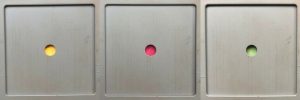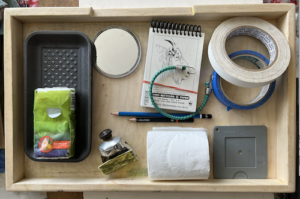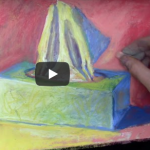One of the most common questions I receive about plein air painting is, “How do you decide what to paint when there is so much to choose from?” My answer? Using a viewfinder can help enormously! The landscape can be so overwhelming and using a viewfinder will help you isolate the part that appeals to you the most.
I recently made a video about using a viewfinder. Have a look at it below.
When using a viewfinder, you will need to close one eye otherwise you’ll see crazy double vision! If you can’t close one eye, then squinting will help but it’s definitely not as useful or satisfying as the one-eyed look.
Using a viewfinder to help you design your thumbnails
The viewfinder I show in the video is one called ViewCatcher. It’s the one I use myself. You can try out all sorts of formats with this viewfinder – just remember to use the same proportions on your paper. For example if you decide on a square opening, make sure your paper is square. If the format of your paper is pretty much decided, for example you have a piece of 9 x 12 in Wallis paper mounted on foamcore, then create a 9 x 12 in window in your viewfinder. The ability to change from one format to another is one of the main reasons I like ViewCatcher!
Create your own viewfinder
You can of course create your own viewfinder by cutting out a rectangular hole in cardboard. If you regularly work on a 9 x 12 in paper which is a 3:4 ratio, then go ahead and cut out a hole measuring 3 x 4 in or if smaller, then 1.5 x 2 in – anything that retains that 3:4 ratio. If you always work square, then cut out a square opening.
Make sure you leave enough cardboard around the hole (like that shown below) to block out the rest of the view. That way you can concentrate on what’s happening in the opening as you move it slowly over your subject. A large surround also helps the viewfinder retain its shape while traveling in your art bag.
Having said all that, I think that the ability to switch easily between formats in the Viewcatcher makes it worth the money. Also, it won’t get bent in your art bag like a piece of cardboard might.

Using a viewfinder to crop a landscape
Let’s have a look at what I mean by using a viewfinder to help you compose your painting. I’ll take an uncropped photo and then crop it in various ways to show you what can happen.

First let’s try out two square crops:


Next let’s look at the same areas but in a vertical rectangular crop:


Now let’s try horizontal crops:


Although I’m cropping a photo, I’m sure you can imagine how this would work on location. Which crop of those above is your favourite? What other ways would you crop the original?
Remember that using a viewfinder will help you not only with choosing what to paint in a landscape. It can help with any subject be it figure, still life, portrait, urban view. Anything!!
Using a viewfinder to help with your drawing
Not only does a viewfinder help you compose your painting, it also helps with the creation of your drawing. Find where lines intersect the edges of the viewfinder and note their position related to the whole ie. a third from the bottom, a quarter from the top. You can also relate the angle a line makes as it moves across the space to the vertical and horizontal lines of the viewfinder itself, for example the line and angle of the rose’s stem.
Here’s the image of the rose with the marks I mention in the video.

Using a viewfinder to help with values
The other thing the ViewCatcher has going for it that I didn’t mention in the video are the two small holes. The colour of the ViewCatcher is 50% grey on the value scale of 1-10. This makes it ever so easy to check the value of a colour against the grey. Look at a spot through one of the holes – is what you are looking at darker or lighter than the grey of the ViewCatcher?
You can then move the ViewCatcher hole over your painting and check how the value there relates to the value of the viewfinder itself. You can also check how accurately you have captured the value of the colour you saw ‘out there’.
Check the image below – look at the top hole and see how light the background is especially when you compare it with the other hole that shows the colour of my hair.

Using a viewfinder to help with colour
These small holes in ViewCatcher can also help you determine the saturation of a colour – how much colour do you see compared to the grey of the viewfinder – is it greyer or more saturated with colour than you think? And what about temperature? Is it warmer or cooler than you think? Run the viewfinder over different areas to compare them one to the other. This is hugely helpful when you are unsure of colour saturation or temperature.
Viewfinder as gift
The other thing is, a viewfinder is a wonderful gift to give to non-artists as it will help them ‘see’ the world in a way they don’t now. I love hearing the ahhs and oohs as they move a viewfinder over whatever is in front of them.
This blog has turned out to be a review of the ViewCatcher as I like it so much!! You can pick one up in many art stores or order it from Amazon here:
Viewcatcher from Amazon.com
I’d love to hear if you use a viewfinder. How helpful is one to your work? Do you use a handmade viewfinder or something like the ViewCatcher? Do you use one all the time or rarely? Let me know by posting a comment on the blog.
I look forward to hearing from you!
~ Gail



























7 thoughts on “Using A Viewfinder Can Help You Create A Better Painting”
Great info Gail, thanks! I find using a viewfinder (I have the grey plastic one) when I am painting en Plein air is very helpful. The subject area is so immense that I can decide my focus and composition, not getting distracted from so many other views.
Of course I may move the tree that’s not in the viewfinder into the composition because it supports the scene. Sandi
Glad you enjoyed the post Sandi. I am so glad you have shared your own experience with using a viewfinder esp en plein air. And yes, moving things around is called artistic licence 🙂
I couldn’t find a viewfinder that worked with many of the canvas sizes that I use, so I had a viewfinder set made. The ten cards on the ring each are a different ratio, so just about every canvas currently sold has a card to match. For example, the 4×5 card works with 8×10, 16×20, 32×40, etc. Here is a link to the set on Etsy. I’d sure appreciate it if you’d take a look, and, if you like what you see, please share with others! https://www.etsy.com/listing/266563291/masterview-artists-viewfinder-set?ref=shop_home_active_1 (The cards are plastic laminated, lightweight, but sturdy enough to last for years. Also, I added a bonus card that has two holes in it for determining color and comparing values.)
Hi Mary, Thanks for that information. I’ll add it here as it may be of interest to my subscribers. I should say I myself have no experience with it so I cannot give it a review. How entrepreneurial of you to create your own set!
You know I hadn’t thought about using the viewfinder to find value. I usually have just kept an eye out for something I wanted to paint, then went and painted after finding my spot. I guess using a viewfinder would help find the view to paint, but I usually have a pretty good idea when I go out, but sorting the values makes using a viewfinder a better choice. I’m going to do that next time I go out!
Thanks!
Grand! Let me know how it goes and if it does help.
Pingback: 3 Essential Things You Need to Know Before You Start Drawing – Paint Splattered